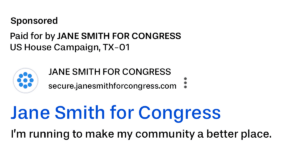Political campaign advertising: How to create effective ads

With political ad spending projected to reach over $10 billion in 2024, it’s clear that many campaigns will rely on paid advertising to get their message in front of the right audiences. Political ads can help you access wide swaths of voters and potential donors, no matter what office your candidate is running for.
Navigating the political campaign advertising landscape can be tricky. In this guide, we’ll explain what political advertising is, how to follow political campaign advertising laws and regulations, and several types of effective political ads so you can formulate the best strategies for your own race.
What is political campaign advertising?
Political campaign advertising is any paid mass communication designed to appeal for votes, support, or donations to a political campaign. This also includes ads created to convince voters not to vote for a particular candidate (opposition or attack ads).
Political campaign ads are often a key part of a campaign’s digital strategy, helping spread the word about their candidate, appeal for donations, and boost public awareness and perception of the campaign.
Political campaign advertising laws
Just like political fundraising regulations, laws about political campaign advertising vary so you should always refer to your relevant election authority to determine which laws apply to your campaign.
However, most political advertising laws relate to including disclaimers (aka disclosures) about who paid for the ad so the public can easily identify it. This might look like recording a candidate voiceover at the end of a video advertisement or adding the text “Paid for by [Name of Campaign]” to the bottom of social media ads.
For example, the FEC rules about advertising disclaimers for federal campaigns include:
- Television ads must contain “a “clearly readable” written statement that appears at the end of the communication, for a period of at least four seconds.”
- Disclaimers on graphic or textual online ads must be visible without users having to click anything.
- Advertisements paid for by a PAC or group other than your campaign should say “Paid for by [committee/funder] and authorized by [your campaign].” (if you authorized it).
- Television and radio advertisements that are paid for and/or authorized by your campaign must include audio of the candidate identifying themself and stating that they approve the message (i.e. “My name is [candidate] and I approve this message”).
Your state may also have additional disclaimer laws about social media advertising specifically. For instance, California has a social media disclosure law that requires campaigns to include the text “Who funded this ad?” followed by a link to a disclosure about the campaign or committee that provided funding.
Types of political ads
Political campaign ads can take a variety of forms, from traditional print advertisements to online strategies. While you may be tempted to prioritize newer, digital ad channels like social media, don’t discount traditional mediums completely — AdImpact reports that broadcast television still represents 50% of all political ad spending.
As you decide how to distribute your advertising budget, consider these five types of political campaign ads:
Television
When it comes to political campaign advertising, cable television is one of the most expensive types of advertising to buy. Campaign videos are better at holding audiences’ attention than written ads, and the combination of visuals and sound helps you connect with voters and donors on an emotional level. However, if you want to consider using video advertisements, you should also consider using CTV or digital advertising to help expand your reach with less cost.
Beyond traditional cable and broadcast television ads, many campaigns leverage connected TV (CTV) for ad distribution. Instead of relying on air time and only accessing linear TV subscribers, CTV allows you to reach voters through streaming and take advantage of better ad targeting. AdImpact expects CTV ads to make up 13% of total political ad spending in 2024.
Social media
Social media is a crucial advertising channel for building your campaign’s online presence and engaging prospective grassroots donors. Most social media advertising takes place on Facebook and Instagram, although you can place political ads on X (formerly Twitter) as well.
When advertising on social media, make sure that you’re aware of per-platform political advertising policies and restrictions (Meta’s policy applies to both Facebook and Instagram).
Print advertisements
Print advertising remains an essential part of political campaigns, especially for down-ballot races. Print political campaign ads may include:
- Direct mail and postcards
- Newspaper and magazine advertisements
- Billboard advertisements
- Campaign signs and posters
Search and display ads
With over eight billion Google searches per day, the Google search results page is prime real estate for advertisers. Search ads appear as “Sponsored” text results at the top of Google search results pages for relevant terms and link users to your website. For example, here’s a text ad for a congressional candidate:

Google has its own political campaign advertising policies that all search ads must comply with.
Display ads, on the other hand, are visual advertisements that appear on pages across the internet, often using ad targeting. These can be static or interactive banner ads like the one shown below:

Audio
The rising popularity of podcasts and audio entertainment makes audio ads (including broadcast radio ads) an exciting opportunity for political campaigns. However, audio is still one of the least prioritized political campaign advertising channels, only comprising 1% of political ad spend in 2022.
Strategies for effective political campaign ads
Ideally, your campaign should create multiple types of political ads to increase the chances of getting your message in front of target voters. Multiple touch points will help your campaign stick in voters’ minds and encourage them to learn more.
To create political campaign ads that stand out and inspire action from voters, use the following strategies:
- Do your research: As part of your campaign planning, you should research the interests and demographics of your and your opposition’s target voters. Refer back to this research when you create your ads to appeal directly to target voters.
- Leverage ad targeting: Ad targeting involves strategically placing your political ads in front of precise audience groups, such as local Democrats who have engaged with similar Facebook pages. Tools like Facebook Ads Manager and NGP VAN’s Digital 8 can help.
- Appeal to your audience’s emotions: Use storytelling to evoke feelings of hope, inspiration, or empowerment so you can establish emotional connections with voters.
- Use diverse approaches to ad content: Aim for a mix of advertising messages, formats, and stories within your ads. Stay consistent with your campaign’s messaging, but vary your advertisements enough that you can appeal to different demographics within your target audience.
- Highlight any campaign endorsements: If you’ve secured an endorsement for your candidate, mention it in your advertisements or ask if the endorser would be willing to appear in a video ad.
- Save a good portion of your budget for the weeks before the election: The month before your election will be the most important time for voters to see your advertisements, so make sure to plan ahead and spend your budget accordingly.
As you try out these strategies, ensure that each of your political campaign ads ends with a clear call to action (CTA) that aligns with your goals for each ad. If the goal of a digital ad is to raise funds, for example, your CTA should be to donate, and the ad should link through to your donation page.
Getting started with political campaign ads
Political campaign advertising helps you connect with voters and donors alike, spreading awareness of your campaign to identified and prospective supporters. Remember to read up on and follow all relevant political advertising laws, and keep your advertisements grounded in your candidate’s message.
To reach more voters and donors with your ads, canvassing activities, and more, power your campaign with the leading software solutions for Democratic and progressive candidates. Contact NGP VAN to get started.




